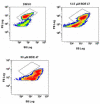Flow cytometric analysis of BDE 47 mediated injury to rainbow trout gill epithelial cells
- PMID: 20053465
- PMCID: PMC3321377
- DOI: 10.1016/j.aquatox.2009.11.013
Flow cytometric analysis of BDE 47 mediated injury to rainbow trout gill epithelial cells
Abstract
The polybrominated diphenyl ethers (PBDEs) are ubiquitous environmental contaminants whose residues are increasing in fish, wildlife and human tissues. However, relatively little is known regarding the mechanisms of cell injury caused by PBDE congeners in fish. In the present study, we employed flow cytometry-based analyses to understand the onset and mechanisms of cell injury in rainbow trout gill cells (RTgill-W1 cells) exposed to 2,2',4,4'-tetrabromodiphenyl ether (BDE 47). Substantial optimization and validation for flow cytometry protocols were required during assay development for the trout gill cell line. Exposure to micromolar concentrations of BDE 47 elicited a significant loss in RTgill-W1 cell viability that was accompanied by a decrease in NAD(P)H autofluorescence, a marker associated with disruption of cellular redox status. This loss in NAD(P)H content was accompanied by a decrease in nonyl acridine orange fluorescence, indicating mitochondrial membrane lipid peroxidation. Furthermore, low doses of BDE 47 altered cellular forward angle light scatter (FS, a measure of cell diameter or size) and side light scatter properties (SS, a measure of cellular internal complexity), consistent with the early stages of apoptosis. These changes were more pronounced at higher BDE 47 concentrations, which led to an increase in the percentage of cells undergoing frank apoptosis as evidenced by sub-G1 DNA content. Apoptosis was also observed at a relatively low dose (3.2muM) of BDE 47 if cells were exposed for an extended period of time (24h). Collectively, the results of these studies indicate that exposure of rainbow trout gill cells to BDE47 is associated with the induction of apoptosis likely originating from disruption of cellular redox status and mitochondrial oxidative injury. The current report extends observations in other species demonstrating that oxidative stress is an important mechanism of BDE 47 mediated cellular toxicity, and supports the use of oxidative stress-associated biomarkers in assessing the sublethal effects of PBDEs and their replacements in fish. The application of flow cytometry endpoints using fish cell lines should facilitate study of the mechanisms of chemical injury in aquatic species.
Figures








Similar articles
-
Comparative oxygen radical formation and toxicity of BDE 47 in rainbow trout cell lines.Mar Environ Res. 2008 Jul;66(1):7-8. doi: 10.1016/j.marenvres.2008.02.007. Epub 2008 Feb 26. Mar Environ Res. 2008. PMID: 18400291 Free PMC article.
-
The role of mitochondrial and oxidative injury in BDE 47 toxicity to human fetal liver hematopoietic stem cells.Toxicol Sci. 2008 Jan;101(1):81-90. doi: 10.1093/toxsci/kfm256. Epub 2007 Oct 4. Toxicol Sci. 2008. PMID: 17916640
-
Cytotoxicity and apoptosis induction on RTG-2 cells of 2,2',4,4'-tetrabromodiphenyl ether (BDE-47) and decabrominated diphenyl ether (BDE-209).Toxicol In Vitro. 2010 Jun;24(4):1190-6. doi: 10.1016/j.tiv.2010.02.012. Epub 2010 Feb 14. Toxicol In Vitro. 2010. PMID: 20159034
-
Reactive oxygen species (ROS) and the calcium-(Ca2+) mediated extrinsic and intrinsic pathways underlying BDE-47-induced apoptosis in rainbow trout (Oncorhynchus mykiss) gonadal cells.Sci Total Environ. 2019 Mar 15;656:778-788. doi: 10.1016/j.scitotenv.2018.11.306. Epub 2018 Nov 22. Sci Total Environ. 2019. PMID: 30530147
-
Effect of parental exposure to trenbolone and the brominated flame retardant BDE-47 on fertility in rainbow trout (Oncorhynchus mykiss).Mar Environ Res. 2008 Jul;66(1):47-9. doi: 10.1016/j.marenvres.2008.02.018. Epub 2008 Feb 26. Mar Environ Res. 2008. PMID: 18397801 Free PMC article.
Cited by
-
Surface defects on plate-shaped silver nanoparticles contribute to its hazard potential in a fish gill cell line and zebrafish embryos.ACS Nano. 2012 May 22;6(5):3745-59. doi: 10.1021/nn204671v. Epub 2012 Apr 13. ACS Nano. 2012. PMID: 22482460 Free PMC article.
-
Effect of omega-3 fatty acid oxidation products on the cellular and mitochondrial toxicity of BDE 47.Toxicol In Vitro. 2015 Jun;29(4):672-80. doi: 10.1016/j.tiv.2015.01.015. Epub 2015 Feb 7. Toxicol In Vitro. 2015. PMID: 25659769 Free PMC article.
References
-
- Ahmed SA, Gogal RM, Jr., Walsh JE. A new rapid and simple non-radioactive assay to monitor and determine the proliferation of lymphocytes: an alternative to [3H]thymidine incorporation assay. J. Immunol. Methods. 1994;170:211–24. - PubMed
-
- Antonsson B. Mitochondria and the Bcl-2 family proteins in apoptosis signaling pathways. Mol. Cell Biochem. 2004;256-257:141–55. - PubMed
-
- Betts KS. Rapidly rising PBDE levels in North America. Environ. Sci. Technol. 2002;36:50A–52A. - PubMed
Publication types
MeSH terms
Substances
Grants and funding
LinkOut - more resources
Full Text Sources

